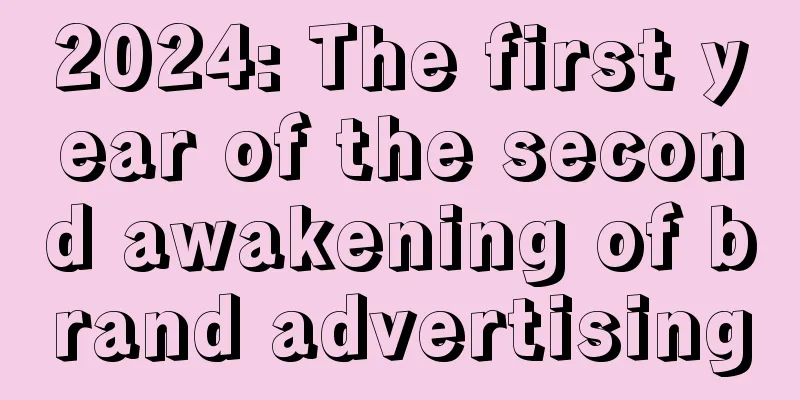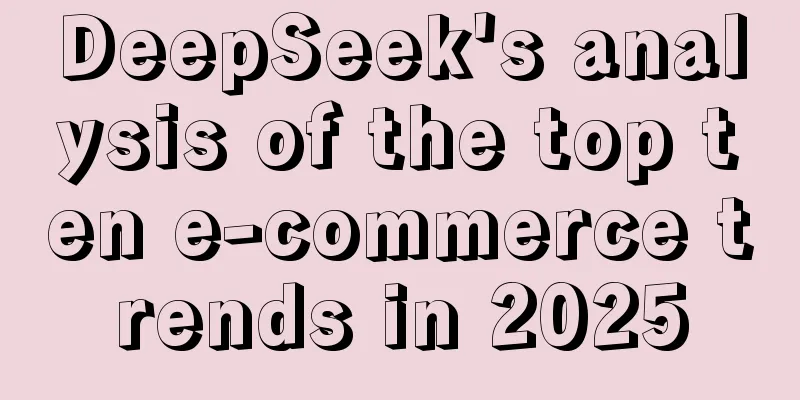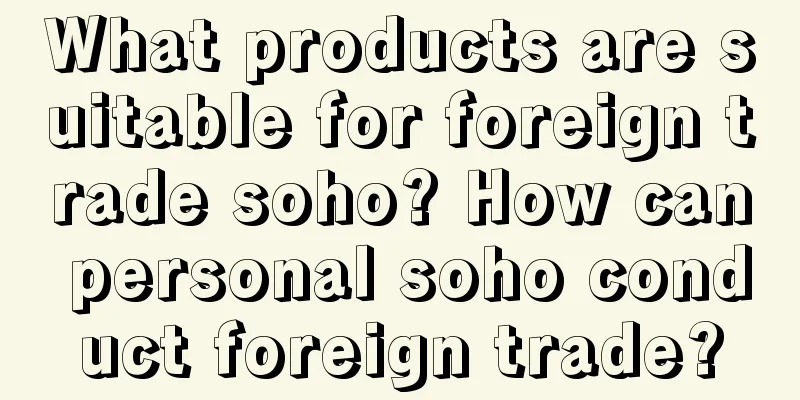2024: The first year of the second awakening of brand advertising

Here’s an interesting piece of data: In recent years, 71% of CEOs have invested their money in performance-based returns due to performance pressure. Compared with 2022, the value of the top 100 global brands in 2023 fell by 19%. The rampant short-term marketing is indeed causing the brand value to decline year by year. Party A Finance has also observed this trend. Advertisers are very concerned about the investment-output ratio of advertising, especially when the 3.8 promotion comes after the holidays, and many brands only look at conversions. When a company only does pure performance advertising, the KPI is indeed easy to achieve at the beginning, and the CEO has no KPI pressure and can even "show off his abilities" in front of investors. However, after converting the group of consumers who are easiest to convert, they will find that it is difficult to break through the circle, and conversion suddenly becomes difficult. The proposition of honest branding is once again placed before them. In 2024, the consumer industry is all about low prices, and the reshuffle has reached a critical moment. There are already enough brands that have failed on the road. No matter how hard the price war is fought, it will not be able to break through the cost limit. Therefore, it is time for brand advertising to have a second awakening. After all, only with brand recognition can we escape from the quagmire of price wars. 1. Pure performance advertising is equivalent to chronic suicideThe heavy attack on pure performance advertising has caused losses to all parties and only benefited a few platforms. "It's easy to become an Internet celebrity brand, but it's difficult to be a long-lasting popular brand." The correctness of this statement has been verified by brands. Relevant data shows that the 24-month survival rate of new brands entering Tmall from 2017 to 2021 has dropped from about 15% to less than 1%. At a time when traffic dividends are declining, only companies that insist on brand investment can survive the cycle. There are many new brands that can create a big hit in just one shopping festival. With immediate sales and a rush of ideas, decision makers will find that performance advertising is too easy to use. It will be obvious after 2-3 years that pure performance advertising will enrich the platform and weaken the brand. First, the more you invest in performance advertising, the more expensive it becomes. On the one hand, the ones that are easy to convert are all obtained at a cheap price, so aren’t the remaining ones a hard nut to crack? On the other hand, traffic prices are usually getting more and more expensive for old customers, because the platform knows that you “can’t stop.” Secondly, the more you invest in performance advertising, the less you understand it. There has always been a clear methodology for brand advertising. David Aaker proposed the "Five-Star Brand Equity Model", Kevin Keller proposed the value chain model and customer equity model, and Jiang Nanchun proposed the dividend of people's hearts, etc. You can copy their homework without hesitation. Although it may not produce immediate results, it is basically correct. Finally, there is the micro-management of performance advertising. Although there is a large amount of structured data available, each company uses this data differently, and some advertisers even rely on intuition. Some platforms will give corresponding reports and guidance in a timely manner, but they can only stay at this level and it is impossible to teach you how to place ads step by step. Ipsos has said that marketers of performance advertising are generally reluctant to share their secrets of success. For example, in the gaming industry, which pursues performance-based advertising the most, half of the materials can only be released for one day, and 19% of the materials are eliminated after two days. These are all sunk costs brought about by performance-based advertising. It is impossible to absolutely quantify which ideas are good and which are bad, so there is naturally no homework to copy. Second, you must see the interest of brand assetsRetell the brand story based on organizational genes and product power. Performance advertising is renting a house, which is characterized by rapid growth and significant short-term effects (move in with your luggage). However, the cost of renting a house will become higher and higher over time, and you will have no house to live in after the investment ends. Brand advertising is like buying a house. Its characteristic is that it may be difficult in the early stage, and operation and accumulation cannot be achieved overnight. However, the users influenced by brand advertising are deposited in the brand bank, and you can see interest every year. What is yours will always be yours. For example, in the past two years, domestic brands Anta, Xtep, Hongxing and Erke have swept the sports world. However, in 2022, Kasper Rorsted, CEO of the international brand Adidas, announced that he would leave early, three years earlier than originally planned. In an interview, Adidas' former CEO said that his early resignation was due to strategic mistakes in the Chinese market. Adidas was too focused on short-term profit, which damaged the long-term development of the brand. In order to pursue sales, it frequently offered discounts and promotions. Although it increased sales, it made users very sensitive to prices. Now everyone is waiting. In contrast, in the past two years, domestic sports brands such as Erke have increased their sales to over 400 yuan after silently donating money, and even marathon runners will buy them at their own expense and recommend them; Anta also has the flag of "increase by 5 and break 8", which means the number of transactions must increase by 5% and the average customer price must exceed 800 yuan. Take Anta as an example. Anta has repeatedly sponsored the Olympic Games and various sports events to amplify its voice. The cost is enough for Anta to hire many anchors to promote its products. In fact, the sales of Olympic products do not account for much, but everyone has the mentality of "not afraid of Nike and Adidas, but afraid of Anta carrying the national flag". In terms of product strength, Anta is also on par with international brands, with various functional shoes and clothing being innovated repeatedly, focusing on the comfort level required by young people in core categories such as running and basketball. Good products and brand advertising have allowed Anta to confidently declare that it aims to be the No. 1 in domestic market share by 2025. Product strength is 1, and brand advertising is the 0 behind it. The order of magnitude of how many "0s" can be achieved depends on the investment in brand advertising. When the "0s" behind it have accumulated, it can grow 10 times, 10 times, and 10 times again. 3. No matter which platform, you must have a "deep relationship" with consumersAlthough brand advertisements are gradually decreasing, they still have deep relationships with consumers in places including but not limited to Xiaohongshu, Focus Media, iQiyi, Bilibili, Weibo, Tencent Advertising, and Douyin (the proportion of which is gradually decreasing). When it comes to brand advertising, the first thing that comes to mind is Focus Media. Because Focus Media holds the "lifeline" of the brand - to make consumers remember it all the time. The inspiration for writing this article came from a dinner party of Party A's financial editorial department. The friends saw Beibingyang in the elevator and remembered that they had not drunk it for a long time, so they took a detour to buy two large cartons of Beibingyang before going to dinner. Consumers may forget what they decide to buy today tomorrow, so the solution is to keep reminding them. Focus Media is letting brands know that performance advertising requires one-to-one precision, while brand advertising requires "scaled" precision. When a brand forms a conditioned reflex among a large number of people and becomes a social consensus, its moat will naturally be deeper than others. The same applies to Xiaohongshu. If you only introduce a product to users, its life cycle will be limited; however, if you can introduce a brand to users, the brand may enjoy repeat purchases; if the brand can continue to introduce a lifestyle to users and integrate the brand into the consumer's lifestyle, it can cater to the changes of different consumers and make them long-term fans. On long video platforms such as iQiyi, Youku, Tencent Video, and Bilibili that do not have the gene to bring goods. Many people think that their brand advertising is just a simple patch. But compared with a 3-second or 5-second patch that is spread 1 million times, a 10-minute video that is spread 10,000 times is more effective in conversion. Last year, there was such a case. Lincoln wanted to do in-depth brand advertising. Tencent Sports + Tencent Video joined forces to produce a series of car road trip programs for Lincoln. Cars + sports IP + adolescent memories boiled together and once became a variety show for car buyers. Cars and other high-priced brands often have long and cautious decision-making cycles. This requires repeatedly watching different brand content in different scenarios, and then only a final push can get the consumer budget. There are also Weibo and Tencent Advertising, one is the largest public opinion field, and the other is the largest private social field, both of which have always been territories that brand advertising has never neglected. For many luxury brands and beauty brands, e-commerce platforms are just a sales channel, and it is difficult to form truly meaningful interactions with consumers. Cultivating consumer awareness and spreading brand characteristics in the largest public opinion and social fields is the foundation for these luxury brands to survive for decades or even hundreds of years. As for TikTok, more and more "effects" have been required in recent years. This is also beyond Douyin's control. Currently, most of Douyin's advertising revenue comes from e-commerce advertising, and the purpose of e-commerce is to return cash and tend to invest more in performance advertising. But in fact, Douyin's brand advertising penetration and coverage are very strong. Some people miss the Douyin atmosphere 21 years ago. Many of the active "Douyin brands" now almost grew up at that time. 4. Big brands are coming back to their sensesConsumption entrances are becoming diversified, and brand effects place more emphasis on "tap water" and "private domain positions." Many people believe that the biggest advantage of performance advertising is that it can be quantified and that what they say is true. However, few people know that when pursuing the integration of brand, effect and sales, there are also many tricks used in performance advertising. Question: If a company sees that 100 new consumers have been converted from a pool of 1,000 people, can it conclude that the advertising is effective? Most people may think that this conversion rate is quite high. But the answer is that it cannot determine whether the advertisement is effective. The best scenario: these 100 people who originally did not know the brand enter the brand. In the future, these 100 people are likely to become tap water, expanding the brand effect. The second best scenario: only 60 out of 100 consumers originally prefer the brand, and the remaining 40 prefer competing brands. The situation of a sleight of hand: These 100 consumers already prefer the brand and convert for the sake of conversion. To make the sleight of hand invisible, do not put the ads in the same advertising basket and make a unified configuration of product + effect. Before 2008, McDonald's almost only invested in promotional advertising. After encountering a growth bottleneck, they began to return to the brand. Later, McDonald's even tested its marketing strategy for five consecutive years and found that 28% of brand advertising can drive 60% of sales, which is the core growth force. P&G also conducted a global test in 2017, reducing 200 million performance ads and found that sales were not affected. Therefore, during the epidemic, they increased their advertising investment, and a 4% increase in advertising investment drove a 6% increase in net profit. In the consumer electronics industry, there is also a saying that brands must take the lead and command technology, not the other way around, otherwise it will just be piling up materials. With the appeal of the second awakening of brand advertising, we need to rebalance brand, performance and sales. Focus Media has previously proposed a ratio of 6:4 for brand advertising and performance advertising. However, this ratio is difficult to achieve in the context of a lack of money and performance in various industries. However, brands that invest in pure performance advertising will find that no matter how they calculate, they cannot get any benefits from the platform. So it is better to keep a calm mindset. When competitors reduce their advertising budgets due to the general environment, capable brands can try to make a gamble on their brands, introduce tap water, create positions, and improve their influence in the long term. Consumers will reward brands they trust, and will also "punish" those they do not trust to a certain extent. 5. Thinking: Re-raising the brand axe80% of users are fickle, disloyal, and have little faith in brands. The uncertainty of the effect needs to be supplemented by the certainty of the brand. The life of a product is limited, but the life of a brand is unlimited. A brand can make products from generation to generation come with their own marketing effects and traffic from the moment they are born. The brand effect is applicable not only in the consumer industry, but also in all industries. In recent years, ESG governance has been in full swing in the capital market. ESG governance is helping companies from all walks of life to build brands in terms of environment, society, and corporate management, thereby driving the market. In the second awakening of brand advertising, we hope that the value of brand advertising will not be overshadowed by performance advertising. The most important thing about a "brand" is not to make products of better quality. The world has never lacked high-quality products. Instead, the brand is needed as an axe to open up scenarios and stimulate the desire for consumption and transactions in order to drive business growth. Chief writer: Zhenhuan Chuan, article architect: Miaomiao Official account: Party A Finance |
<<: Digging out new groups from old categories, a super opportunity for the Super Bowl
>>: “AI Resurrection”, comfort or business?
Recommend
In the “ear economy”, how to tell a good brand story in podcasts? | Osmo Awards 2024
In the era of "ear economy", podcast mar...
What is Amazon PoA? What does it include?
Amazon is the world's largest cross-border e-c...
Is Shopee cross-border e-commerce profitable? What is the logic behind making money?
Today I will introduce you to cross-border e-comme...
0 budget, the way to rejuvenate the brand has changed again!
Has the way contemporary brands are playing with y...
The trend of virtual anchors selling goods is on the rise, but who can make it to the end?
In this article, the author analyzes the advantage...
Xiaoguan Tea: The era of making quick money is over.
Xiaoguan Tea has gone from "masterpiece"...
How important is the role of reviews in online shopping?
Reading reviews when shopping online is an importa...
How to place Amazon DSP ads? What is the placement strategy?
The placement of Amazon DSP ads is different from ...
How much is the Vat tax deduction on Amazon Germany? What materials are required to apply for a tax number?
If you open a store on Amazon's German site, y...
Who was cured by the boring live broadcast?
Looking back at the live broadcast content ecology...
Is it profitable to sell products by following others on Amazon? Is there any risk in doing so?
Some products on Amazon sell well, so there will b...
9 ways to make money by selling clothes on Douyin
If you want to start your own clothing sales busin...
How can cross-border e-commerce achieve higher profits? How to set prices?
With the continuous advancement of global economic...
The key to success in e-commerce: the speed of making beautiful pictures determines the speed of making money
In the field of Pinduoduo e-commerce, the key to m...
Second only to Dior and Chanel, with annual sales exceeding 100 million, how did this perfume brand enter the private domain?
This article uses Jo Malone's private domain o...









